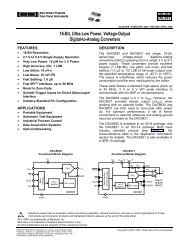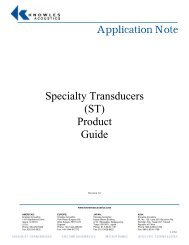AD7714* 3 V/5 V, CMOS, 500 µA Signal Conditioning ADC - dreamm
AD7714* 3 V/5 V, CMOS, 500 µA Signal Conditioning ADC - dreamm
AD7714* 3 V/5 V, CMOS, 500 µA Signal Conditioning ADC - dreamm
Create successful ePaper yourself
Turn your PDF publications into a flip-book with our unique Google optimized e-Paper software.
AD7714<br />
The part also offers ZS Self-Calibration and FS Self-Calibration<br />
options. In these cases, the part performs just a zero-scale or<br />
full-scale calibration respectively and not a full calibration of the<br />
part. A full-scale calibration should not be carried out unless<br />
the part contains valid zero-scale coefficients. These calibrations<br />
are initiated on the AD7714 by writing the appropriate values<br />
(1, 1, 0 for ZS Self-Calibration and 1, 1, 1 for FS Self Calibration)<br />
to the MD2, MD1 and MD0 bits of the Mode Register.<br />
The zero-scale or full-scale calibration is exactly the same as<br />
that described for the full self-calibration. In these cases, the<br />
duration of the calibration is 3 × 1/Output Rate. At this time the<br />
MD2, MD1 and MD0 bits in the Mode Register return to<br />
0, 0, 0. This gives the earliest indication that the calibration<br />
equence is complete. The DRDY line goes high when calibration<br />
is initiated and does not return low until there is a valid<br />
new word in the data register. The time from the calibration<br />
command being issued to DRDY going low is 6 × 1/Output<br />
Rate. This is made up of 3 × 1/Output Rate for the zero-scale or<br />
full-scale calibration and 3 × 1/Output Rate for a conversion on<br />
the analog input. If DRDY is low before (or goes low during)<br />
the calibration command write to the Mode Register, it may<br />
take up to one modulator cycle (MCLK IN/128) before DRDY<br />
goes high to indicate that calibration is in progress. Therefore,<br />
DRDY should be ignored for up to one modulator cycle after<br />
the last bit of the calibration command is written to the Mode<br />
Register.<br />
The fact that the self-calibration can be performed as a two step<br />
calibration offers another feature. After the sequence of a full<br />
self calibration has been completed, additional offset or gain<br />
calibrations can be performed by themselves to adjust the part’s<br />
zero point or gain. Calibrating one of the parameters, either offset<br />
or gain, will not affect the other parameter.<br />
System Calibration<br />
System calibration allows the AD7714 to compensate for system<br />
gain and offset errors as well as its own internal errors. System<br />
calibration performs the same slope factor calculations as selfcalibration<br />
but uses voltage values presented by the system to<br />
the AIN inputs for the zero- and full-scale points. Full System<br />
calibration requires a two step process, a ZS System Calibration<br />
followed by a FS System Calibration.<br />
For a full system calibration, the zero-scale point must be presented<br />
to the converter first. It must be applied to the converter<br />
before the calibration step is initiated and remain stable until the<br />
step is complete. Once the system zero scale has been set up at<br />
the analog input, a ZS System Calibration is then initiated by<br />
writing the appropriate values (0, 1, 0) to the MD2, MD1 and<br />
MD0 bits of the Mode Register. The zero-scale system calibration<br />
is performed at the selected gain. The duration of the calibration<br />
is 3 × 1/Output Rate. At this time, the MD2, MD1 and<br />
MD0 bits in the Mode Register return to 0, 0, 0. This gives the<br />
earliest indication that the calibration sequence is complete. The<br />
DRDY line goes high when calibration is initiated and does not<br />
return low until there is a valid new word in the data register.<br />
The time from the calibration command being issued to DRDY<br />
going low is 4 × 1/Output Rate. This is made up of 3 × 1/Output<br />
Rate for the zero-scale system calibration and 1/Output Rate for<br />
a conversion on the analog input. This conversion on the analog<br />
input is on the same voltage as the zero-scale system calibration<br />
and, therefore, the resultant word in the data register from this<br />
conversion should be a zero-scale reading. If DRDY is low before<br />
(or goes low during) the calibration command write to the<br />
Mode Register, it may take up to one modulator cycle<br />
(MCLK IN/128) before DRDY goes high to indicate that calibration<br />
is in progress. Therefore, DRDY should be ignored for<br />
up to one modulator cycle after the last bit of the calibration<br />
command is written to the Mode Register.<br />
After the zero-scale point is calibrated, the full-scale point is<br />
applied to AIN and the second step of the calibration process is<br />
initiated by again writing the appropriate values (0, 1, 1) to<br />
MD2, MD1 and MD0. Again the full-scale voltage must be set<br />
up before the calibration is initiated, and it must remain stable<br />
throughout the calibration step. The full-scale system calibration<br />
is performed at the selected gain. The duration of the calibration<br />
is 3 × 1/Output Rate. At this time, the MD2, MD1 and<br />
MD0 bits in the Mode Register return to 0, 0, 0. This gives the<br />
earliest indication that the calibration sequence is complete. The<br />
DRDY line goes high when calibration is initiated and does not<br />
return low until there is a valid new word in the data register.<br />
The time from the calibration command being issued to DRDY<br />
going low is 4 × 1/Output Rate. This is made up of 3 × 1/Output<br />
Rate for the full-scale system calibration and 1/Output Rate<br />
for a conversion on the analog input. This conversion on the<br />
analog input is on the same voltage as the full-scale system calibration<br />
and, therefore, the resultant word in the data register<br />
from this conversion should be a full-scale reading. If DRDY is<br />
low before (or goes low during) the calibration command write<br />
to the Mode Register, it may take up to one modulator cycle<br />
(MCLK IN/128) before DRDY goes high to indicate that calibration<br />
is in progress. Therefore, DRDY should be ignored for<br />
up to one modulator cycle after the last bit of the calibration<br />
command is written to the Mode Register.<br />
In the unipolar mode, the system calibration is performed<br />
between the two endpoints of the transfer function; in the bipolar<br />
mode, it is performed between midscale (zero differential<br />
voltage) and positive full scale.<br />
The fact that the system calibration is a two step calibration<br />
offers another feature. After the sequence of a full system calibration<br />
has been completed, additional offset or gain calibrations<br />
can be performed by themselves to adjust the system zero<br />
reference point or the system gain. Calibrating one of the<br />
parameters, either system offset or system gain, will not affect<br />
the other parameter. A full-scale calibration should not be carried<br />
out unless the part contains valid zero-scale coefficients.<br />
System calibration can also be used to remove any errors from<br />
source impedances on the analog input when the part is used in<br />
unbuffered mode. A simple R, C antialiasing filter on the front<br />
end may introduce a gain error on the analog input voltage but<br />
the system calibration can be used to remove this error.<br />
–22–<br />
REV. B















